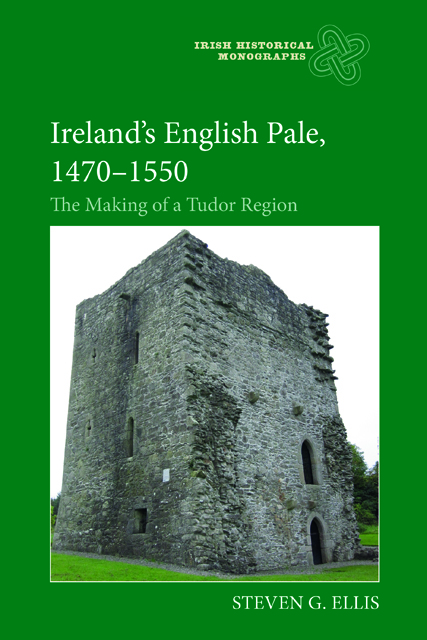Book contents
- Frontmatter
- Contents
- List of Maps
- Preface
- List of Abbreviations
- Introduction: in search of Ireland's English Pale
- 1 The horizons of English rule: retreat and recovery
- 2 The fortifications and identity of a military frontier
- 3 County Dublin and the military frontier
- 4 Strengthening the march in County Kildare
- 5 The English Pale's westward expansion: County Meath
- 6 The English Pale's northern frontier: County Louth
- 7 Restoring the English Pale, 1534-41
- 8 The waning of the English Pale
- Conclusion: an English region in Tudor Ireland
- Bibliography
- Index
- Irish Historical Monographs previous volumes
6 - The English Pale's northern frontier: County Louth
Published online by Cambridge University Press: 09 January 2024
- Frontmatter
- Contents
- List of Maps
- Preface
- List of Abbreviations
- Introduction: in search of Ireland's English Pale
- 1 The horizons of English rule: retreat and recovery
- 2 The fortifications and identity of a military frontier
- 3 County Dublin and the military frontier
- 4 Strengthening the march in County Kildare
- 5 The English Pale's westward expansion: County Meath
- 6 The English Pale's northern frontier: County Louth
- 7 Restoring the English Pale, 1534-41
- 8 The waning of the English Pale
- Conclusion: an English region in Tudor Ireland
- Bibliography
- Index
- Irish Historical Monographs previous volumes
Summary
County Louth (or Uriel) was much the smallest of the English Pale’s four obedient shires. For reasons which will be considered below, the frontiers and political dynamics of early Tudor Louth also saw less movement than those of the other three shires where, as the ruling magnate, the Kildare earls had a greater stake. Louth was divided into just five baronies, and also had a shorter length of frontier to defend. Small parts of Dundalk and Louth baronies in the north-west, plus the entire barony of Cooley, lay in the marches; but well over half of the shire was within the Pale maghery. The march–maghery boundary in County Louth ran broadly south-west from Dundalk. South-east of this boundary, the shire’s wide coastal plain from Dundalk as far as Drogheda had been heavily feudalized. This had in turn encouraged the early development of a county community with a vigorous gentry to rule and defend the shire, discour-aging deep Irish penetrations into the English heartland.
The shire’s medieval background is fairly well known, thanks largely to the important work of Professor Brendan Smith; but early Tudor Louth has received less attention from historians than other Pale shires. Unusually, the early Tudor shire lacked a resident peer to oversee the organization of defence, but in 1541 one of the shire’s most capable marchers, Oliver Plunkett of Bewley, whose principal manor of Tallonstown fronted the MacMahon lordship of Farney, was advanced to the peerage as Baron Louth, when he also received a grant of the nearby dissolved Augustinian abbey of Louth. Earlier, leadership of the shire had often fallen to the archbishop of Armagh who was normally resident there, except for the last five years of Archbishop Kite’s rule as primate (1516–21). Although the archbishop’s annual income, valued at £183 17s. 1½d. in 1538, was modest for an archbishop, it nonetheless made him one of the king’s richest subjects in Louth. The archbishop’s chief manors around Termonfeckin and Dromiskin on the coast were secure enough from Irish raids; but Armagh diocese extended well into the Irishry, where the archbishop’s cathedral at Armagh lay.
- Type
- Chapter
- Information
- Ireland's English Pale, 1470-1550The Making of a Tudor Region, pp. 125 - 135Publisher: Boydell & BrewerPrint publication year: 2021



